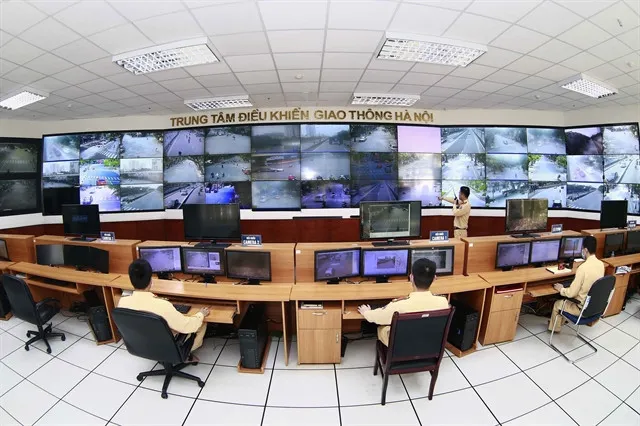Hanoi launches intelligent transport system
Hanoi joins the global trend of developing an intelligent transport system.
Hanoi's Transport Department on July 4 launched the intelligent transportation system (ITS), which is expected to ensure traffic safety and order, cut travel costs and time, and protect the environment.
Chairman of the Hanoi People's Committee Tran Sy Thanh (4th from left), Vice Secretary of the Hanoi Party Committee Nguyen Thi Tuyen (in purple), Vice Chairman of Hanoi People's Committee Nguyen Manh Quyen (3rd left) and other officials at the ceremony inaugurating the ITS in Hanoi. Photo: Pham Cong/The Hanoi Times |
The deployment of ITS is part of the digital transformation plan adopted by the Hanoi Party Committee, which aims to make the capital a smart and modern city connected to a global network of smart metropolises by 2030.
Thai Ho Phuong, Director of the Hanoi Traffic Management and Operation Center, said that Hanoi's ITS integrates technologies in the management and operation of the traffic system with traffic monitoring cameras, speed cameras, and variable message signs (VMS).
"The ITS will monitor the traffic system, provide traffic information, help manage traffic order and safety violations, as well as control public transport, incidents, infrastructure, parking, and payment for electronic public transport tickets," Phuong said.
Director of the Hanoi Department of Transport Nguyen Phi Thuong stressed that the system will serve as a foundation for the completion of the capital's intelligent transport project in the near future.
Hanoi Party's Vice Secretary Nguyen Thi Tuyen and Mayor Tran Sy Thanh visit the Traffic Operations Center. Photo: Pham Cong/The Hanoi Times |
"Experience from developed countries around the world has shown that a smart city is formed by smart government, smart economy, smart transportation, smart environment, smart people, and smart life," Thuong said.
He went on to say that the department will work with relevant departments to thoroughly evaluate ITS operations to fine-tune them, particularly the Traffic Operations Center.
The Hanoi ITS roadmap will consist of three phases: Phase 1 (2024-2026) will see the installation and operation of the Traffic Operations Center; Phase 2 (2027-2029) the expansion of the Traffic Operations Center; and Phase 3 (2030) will focus on sustainable development.
The groundwork for the application of science and technology to traffic management and operations in Hanoi was laid in 2014 when the Hanoi People's Committee tasked the city's Department of Transportation with the renovation and upgrade of the traffic light control center and peripherals.
Intelligent transportation applications in Hanoi include a bus search application, surveillance cameras to ensure bus operations, software to manage road traffic infrastructure systems, and electronic passes on some bus routes.
On-duty traffic police officers handle traffic violations through the surveillance camera system at the Hanoi Traffic Control Center. Photo: VNA |














